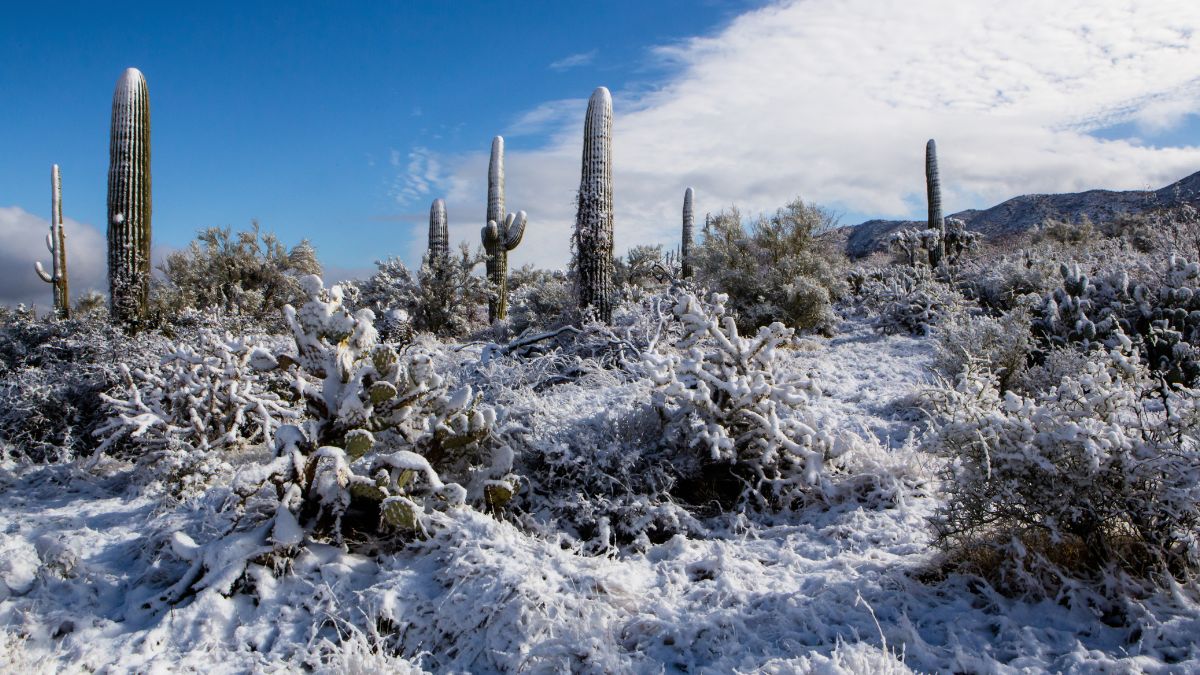Mother Nature occasionally surprises us with her capriciousness. One of the most intriguing surprises is the occurrence of snowfall in the Sahara Desert. This rare and enigmatic phenomenon has captured the world’s imagination and inspired both awe and curiosity.
Occurrence Of Snow In The Sahara
Snow fell in the Sahara Desert in Northwestern Algeria for the 5th time in 42 years. pic.twitter.com/oIRhP0eo5s
— Kibitok 🇰🇪 (@KibitokEmmanuel) January 26, 2022
The Sahara Desert, known for its unforgiving climate and endless stretches of arid sands, is one of the last places on Earth where you would expect to find snow. It is typically associated with scorching temperatures, desiccated landscapes, and relentless sunshine. Yet, every once in a while, a rare meteorological event transforms this inhospitable environment into a winter wonderland.
However, the occurrence of snow in the Sahara is an extraordinary event, happening only a few times in a century. One of the most well-documented instances of snowfall in the Sahara occurred in December 2016. Pictures and videos of the desert blanketed in a pristine layer of white, went viral across the globe, sparking astonishment and wonder. This phenomenon, while infrequent, is not entirely unheard of and can be attributed to a combination of unique climatic factors.
Snow fell in the northern hemisphere winters of 1979, 2016, 2017, 2018, 2021, and 2022 at the Algerian town of An Séfra. The sand dunes were very lightly dusted in this most recent occurrence. But higher elevation places experienced up to 30 cm of snowfall in 2018 (for example). The Atlas Mountains include a number of ski resorts (mostly with artificial snow, though), suggesting that snow occurs here rather frequently.
Also Read: Not Egypt, But This African Country Has The Most Number Of Pyramids!
Climatic Factors Behind Snowfall In The Sahara Desert
View this post on Instagram
Sahara’s heart experiences hyperarid conditions and receives less than 100 mm of annual rainfall. And three of its four sides are bordered by water. Low-pressure cyclones in the northern Sahara during the winter and monsoon rains in the southern Sahara during the summer bring moist air into the area from the Atlantic Ocean, Mediterranean Sea, and Indian Ocean. As a result, the desert’s edges are wetter than its heart. This indicates that the edges of the desert are where snow is most likely to form.
The Sahara’s immensity (90 lakh sq km) and isolation are important characteristics. This means that satellite remote sensing methods rather than field observations are being employed to map the time, volume and distribution of rainfall and snowfall. This, however, only applies to recent decades; there is scant evidence for snowfall patterns occurring before the 1970s when satellite records first became accessible.
Climate change has led to shifts in atmospheric patterns. Probably, making it increasingly possible for cold air masses to penetrate deeper into North Africa. While this doesn’t directly cause snowfall, it increases the likelihood of the necessary conditions aligning for it to occur.
What A Sight It Must Be!
Rare #snow covers the #Sahara #Desert in #Algeria – Second year in a row after 40 years of absence https://t.co/5v81PrFb0s via @Strange_Sounds pic.twitter.com/1arXOMEAKb
— Strange Sounds (@Strange_Sounds) January 7, 2018
For many, it is seen as a rare and mystical event. The sight of snow-covered dunes and palm trees creates a surreal and otherworldly landscape. The juxtaposition of snow against the backdrop of golden sand dunes creates a stunning and unforgettable sight.
Photographers and travellers flock to the Sahara to capture this extraordinary event. It’s almost as if you’ve stepped into a fairytale where the impossible becomes reality. For those fortunate enough to witness it, the experience is surreal and dreamlike.
While it remains a rare occurrence, the factors that contribute to it are a reminder of the intricate interplay of atmospheric and geographical elements.
Are you amazed by this phenomenon in the Sahara Desert?
Cover image credits: Canva
For more such snackable content, interesting discoveries and latest updates on food, travel and experiences in your city, download the Curly Tales App. Download HERE.
Good news! We are on WhatsApp! Subscribe to Curly Tales WhatsApp Channel to stay up-to-date with exclusive content and BTS. Join HERE.
First Published: October 18, 2023 7:27 PM



